Understanding dense hydrogen at planetary conditions
Materials at high pressures and temperatures are of great interest for planetary science and astrophysics, warm dense-matter physics and inertial confinement fusion research. Planetary structure models rely on an understanding of the behaviour of elements and their mixtures under conditions that do not exist on Earth; at the same time, planets serve as natural laboratories for studying materials at extreme conditions. The topic of dense hydrogen is timely given the recent accurate measurements of the gravitational fields of Jupiter and Saturn, the current and upcoming progress in shock experiments, and the advances in numerical simulations of materials at high pressure. In this Review we discuss the connection between modelling planetary interiors and the high-pressure physics of hydrogen and helium. We summarize key experiments and theoretical approaches for determining the equation of state and phase diagram of hydrogen and helium. We relate this to current knowledge of the internal structures of Jupiter and Saturn, and discuss the importance of high-pressure physics to their characterization.
Key points
- Modelling planetary interiors relies on a profound knowledge of the behaviour of materials at high pressures and temperatures. For the gas giant planets, these materials are hydrogen and helium.
- Progress in high-pressure experiments using diamond anvil cells and shock waves is critical for understanding hydrogen under extreme conditions and for calibrating theoretical models
- Simulations of hydrogen at high pressure are essential to understand fundamental physical problems such as its rich phase diagram; assist the experimental realization and interpretation of new materials; and predict its behaviour for parameters at which experiments cannot be performed.
- Jupiter and Saturn are expected to have complex interiors in which hydrogen metallizes and helium separates from hydrogen. The full understanding of these processes is still a major challenge in high-pressure physics.
- Although the structure and evolution of gas giant planets are dominated by hydrogen and helium, the planets contain other, heavier elements and can have complex interiors that include composition gradients and inhomogeneous regions.
This is a preview of subscription content, access via your institution
Access options
Access Nature and 54 other Nature Portfolio journals
Get Nature+, our best-value online-access subscription
cancel any time
Subscribe to this journal
Receive 12 digital issues and online access to articles
111,02 € per year
only 9,25 € per issue
Buy this article
- Purchase on SpringerLink
- Instant access to full article PDF
Prices may be subject to local taxes which are calculated during checkout
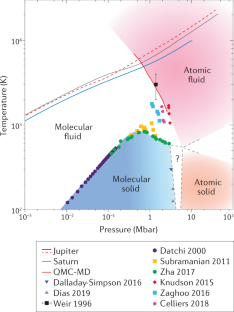
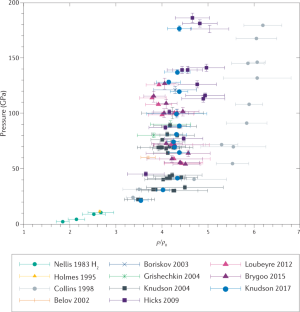
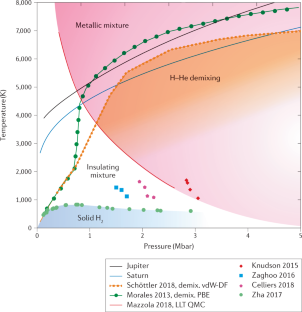
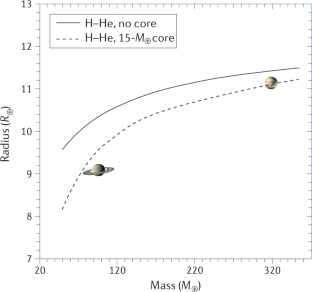

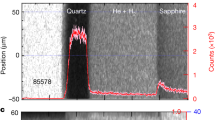
Evidence of hydrogen−helium immiscibility at Jupiter-interior conditions
Article 26 May 2021
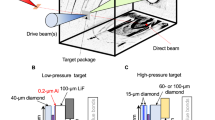
Structure and density of silicon carbide to 1.5 TPa and implications for extrasolar planets
Article Open access 27 April 2022
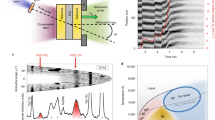
Implications of the iron oxide phase transition on the interiors of rocky exoplanets
Article 11 February 2021
References
- McMahon, J. M., Morales, M. A., Pierleoni, C. & Ceperley, D. M. The properties of hydrogen and helium under extreme conditions. Rev. Mod. Phys.84, 1607–1653 (2012). ADSGoogle Scholar
- Wigner, E. & Huntington, H. B. On the possibility of a metallic modification of hydrogen. J. Chem. Phys.3, 764–770 (1935). ADSGoogle Scholar
- Helled, R., Anderson, J. D., Podolak, M. & Schubert, G. Interior models of Uranus and Neptune. Astrophys. J.726, 15 (2011). ADSGoogle Scholar
- Ashcroft, N. W. Metallic hydrogen: a high-temperature superconductor? Phys. Rev. Lett.21, 1748–1749 (1968). ADSGoogle Scholar
- Babaev, E., Sudbø, A. & Ashcroft, N. A superconductor to superfluid phase transition in liquid metallic hydrogen. Nature431, 666 (2004). ADSGoogle Scholar
- Goncharov, A. Phase diagram of hydrogen at extreme pressures and temperatures; updated through 2019 (Review article). Low Temp. Phys.46, 97–103 (2020). ADSGoogle Scholar
- Weir, S., Mitchell, A. & Nellis, W. Metallization of fluid molecular hydrogen at 140 GPa (1.4 Mbar). Phys. Rev. Lett.76, 1860 (1996). ADSGoogle Scholar
- Goncharov, A. F., Mazin, I. I., Eggert, J. H., Hemley, R. J. & Mao, H.-k Invariant points and phase transitions in deuterium at megabar pressures. Phys. Rev. Lett.75, 2514–2517 (1995). ADSGoogle Scholar
- Dias, R. P. & Silvera, I. F. Observation of the Wigner–Huntington transition to metallic hydrogen.Science355, 715–718 (2017). ADSGoogle Scholar
- Datchi, F., Loubeyre, P. & LeToullec, R. Extended and accurate determination of the melting curves of argon, helium, ice (H2O), and hydrogen (H2). Phys. Rev. B61, 6535–6546 (2000). ADSGoogle Scholar
- Deemyad, S. & Silvera, I. F. Melting line of hydrogen at high pressures. Phys. Rev. Lett.100, 155701 (2008). ADSGoogle Scholar
- Dzyabura, V., Zaghoo, M. & Silvera, I. F. Evidence of a liquid–liquid phase transition in hot dense hydrogen. Proc. Natl Acad. Sci. USA110, 8040–8044 (2013). ADSGoogle Scholar
- Zaghoo, M., Salamat, A. & Silvera, I. F. Evidence of a first-order phase transition to metallic hydrogen. Phys. Rev. B93, 155128 (2016). ADSGoogle Scholar
- Zaghoo, M. & Silvera, I. F. Conductivity and dissociation in liquid metallic hydrogen and implications for planetary interiors. Proc. Natl Acad. Sci. USA114, 11873–11877 (2017). ADSGoogle Scholar
- Dubrovinsky, L. et al. The most incompressible metal osmium at static pressures above 750 gigapascals. Nature525, 226–229 (2015). ADSGoogle Scholar
- Loubeyre, P., Occelli, F. & Dumas, P. Synchrotron infrared spectroscopic evidence of the probable transition to metal hydrogen. Nature577, 631–635 (2020). ADSGoogle Scholar
- Goncharov, A. F. & Struzhkin, V. V. Comment on ‘‘Observation of the Wigner–Huntington transition to metallic hydrogen’’. Science357, eaam9736 (2017). Google Scholar
- Liu, X.-D. & Dalladay-Simpson, P. & Howie, R. T. & Li, B. & Gregoryanz, E. Comment on ‘‘Observation of the Wigner–Huntington transition to metallic hydrogen”. Science357, eaan2286 (2017). Google Scholar
- Loubeyre, P., Occelli, F. & Dumas, P. Comment on: ‘‘Observation of the Wigner–Huntington transition to metallic hydrogen’’. Preprint at http://arxiv.org/abs/1702.07192 (2017).
- Eremets, M. & Drozdov, A. Comments on the claimed observation of the Wigner–Huntington transition to metallic hydrogen. Preprint at https://arxiv.org/abs/1702.05125 (2017).
- Geng, H. Y. Public debate on metallic hydrogen to boost high pressure research. Matter Radiat. Extremes2, 275 (2018). Google Scholar
- Silvera, I. & Dias, R. Response to comment on ‘‘Observation of the Wigner–Huntington transition to metallic hydrogen”. Science357, eaan1215 (2017). Google Scholar
- Silvera, I. & Dias, R. Response to critiques on observation of the Wigner–Huntington transition to metallic hydrogen. Preprint at http://arxiv.org/abs/1703.0306 (2017).
- Howie, R. T., Dalladay-Simpson, P. & Gregoryanz, E. Raman spectroscopy of hot hydrogen above 200 GPa. Nat. Mater.14, 495–499 (2015). ADSGoogle Scholar
- Dalladay-Simpson, P., Howie, R. T. & Gregoryanz, E. Evidence for a new phase of dense hydrogen above 325 gigapascals. Nature529, 63–67 (2016). ADSGoogle Scholar
- Eremets, M., Troyan, I. & Drozdov, A. Low temperature phase diagram of hydrogen at pressures up to 380 GPa. A possible metallic phase at 360 GPa and 200 K. Preprint at http://arxiv.org/abs/1601.04479 (2016).
- Dias, R. P., Noked, O. & Silvera, I. F. Quantum phase transition in solid hydrogen at high pressure. Phys. Rev. B100, 184112 (2019). ADSGoogle Scholar
- Eremets, M. I., Drozdov, A. P., Kong, P. & Wang, H. Semimetallic molecular hydrogen at pressure above 350 GPa. Nat. Phys.15, 1246–1249 (2019). Google Scholar
- Gregoryanz, E. et al. Everything you always wanted to know about metallic hydrogen but were afraid to ask. Matter Radiat. Extremes5, 038101 (2020). Google Scholar
- Dias, R. P. & Silvera, I. F. Observation of the Wigner–Huntington transition to metallic hydrogen. Science355, 715–718 (2017). ADSGoogle Scholar
- Nellis, W. Ultracondensed Matter by Dynamic Compression (Cambridge Univ. Press, 2017).
- Nellis, W. J. Dense quantum hydrogen. Low Temp. Phys.45, 294–296 (2019). ADSGoogle Scholar
- Knudson, M. et al. Direct observation of an abrupt insulator-to-metal transition in dense liquid deuterium. Science348, 1455–1460 (2015). ADSGoogle Scholar
- Celliers, P. M. et al. Insulator–metal transition in dense fluid deuterium. Science361, 677–682 (2018). ADSGoogle Scholar
- Mochalov, M. A. et al. Quasi-isentropic compressibility of deuterium at a pressure of ~12 TPa. JETP Lett.107, 168–174 (2018). ADSGoogle Scholar
- Brygoo, S. et al. Analysis of laser shock experiments on precompressed samples using a quartz reference and application to warm dense hydrogen and helium. J. Appl. Phys.118, 195901 (2015). ADSGoogle Scholar
- Miller, J. E. et al. Streaked optical pyrometer system for laser-driven shock-wave experiments on omega. Rev. Sci. Instrum.78, 034903 (2007). ADSGoogle Scholar
- Knudson, M. D. & Desjarlais, M. P. High-precision shock wave measurements of deuterium: evaluation of exchange-correlation functionals at the molecular-to-atomic transition. Phys. Rev. Lett.118, 035501 (2017). ADSGoogle Scholar
- Knudson, M. D. et al. Probing the interiors of the ice giants: shock compression of water to 700 GPa and 3.8 g/cm 3 . Phys. Rev. Lett.108, 091102 (2012). ADSGoogle Scholar
- Millot, M. et al. Nanosecond X-ray diffraction of shock-compressed superionic water ice. Nature569, 251 (2019). ADSGoogle Scholar
- Eremets, M. I. & Trojan, I. Evidence of maximum in the melting curve of hydrogen at megabar pressures. JETP Lett.89, 174–179 (2009). ADSGoogle Scholar
- Subramanian, N., Goncharov, A. F., Struzhkin, V. V., Somayazulu, M. & Hemley, R. J. Bonding changes in hot fluid hydrogen at megabar pressures. Proc. Natl Acad. Sci. USA108, 6014–6019 (2011). ADSGoogle Scholar
- Zha, C.-s, Liu, H., Tse, J. S. & Hemley, R. J. Melting and high P−T transitions of hydrogen up to 300 GPa. Phys. Rev. Lett.119, 075302 (2017). Google Scholar
- Zha, C.-S., Liu, Z., Ahart, M., Boehler, R. & Hemley, R. J. High-pressure measurements of hydrogen phase IV using synchrotron infrared spectroscopy. Phys. Rev. Lett.110, 217402 (2013). ADSGoogle Scholar
- Mott, N. F. The transition to the metallic state. Phil. Mag.6, 287–309 (1961). ADSGoogle Scholar
- Ohta, K. et al. Phase boundary of hot dense fluid hydrogen. Sci. Rep.5, 16560 (2015). ADSGoogle Scholar
- Ross, M., Ree, F. & Young, D. The equation of state of molecular hydrogen at very high density. J. Chem. Phys.79, 1487–1494 (1983). ADSGoogle Scholar
- Saumon, D., Chabrier, G. & Van Horn, H. An equation of state for low-mass stars and giant planets. Astrophys. J. Suppl. Ser.99, 713 (1995). ADSGoogle Scholar
- Chabrier, G., Mazevet, S. & Soubiran, F. A new equation of state for dense hydrogen–helium mixtures. Astrophys. J.872, 51 (2019). ADSGoogle Scholar
- Ross, M. Linear-mixing model for shock-compressed liquid deuterium. Phys. Rev. B58, 669–677 (1998). ADSGoogle Scholar
- Kerley, G. I. Equations of state for hydrogen and deuterium. Sandia National Laboratories report SAND 2003–3613 (SAND, 2003).
- Caillabet, L., Mazevet, S. & Loubeyre, P. Multiphase equation of state of hydrogen from ab initio calculations in the range 0.2 to 5 g/cc up to 10 eV. Phys. Rev. B83, 094101 (2011). ADSGoogle Scholar
- Militzer, B. & Hubbard, W. B. Ab initio equation of state for hydrogen–helium mixtures with recalibration of the giant-planet mass–radius relation. Astrophys. J.774, 148 (2013). ADSGoogle Scholar
- Militzer, B. Equation of state calculations of hydrogen–helium mixtures in solar and extrasolar giant planets. Phys. Rev. B87, 014202 (2013). ADSGoogle Scholar
- Becker, A. et al. Ab initio equations of state for hydrogen (H-REOS. 3) and helium (He-REOS. 3) and their implications for the interior of brown dwarfs. Astrophys. J. Suppl. Ser.215, 21 (2014). ADSGoogle Scholar
- Brush, S., Sahlin, H. & Teller, E. Monte Carlo study of a one-component plasma. I. J. Chem. Phys.45, 2102–2118 (1966). ADSGoogle Scholar
- Morales, M. A., McMahon, J. M., Pierleoni, C. & Ceperley, D. M. Nuclear quantum effects and nonlocal exchange-correlation functionals applied to liquid hydrogen at high pressure. Phys. Rev. Lett.110, 065702 (2013). ADSGoogle Scholar
- Allen, M. P. & Tildesley, D. J. Computer Simulation of Liquids (Clarendon, 1987).
- Pierleoni, C., Ceperley, D. M. & Holzmann, M. Coupled electron–ion Monte Carlo calculations of dense metallic hydrogen. Phys. Rev. Lett.93, 146402 (2004). ADSGoogle Scholar
- Payne, M. C., Teter, M. P., Allan, D. C., Arias, T. A. & Joannopoulos, J. D. Iterative minimization techniques for ab initio total-energy calculations: molecular dynamics and conjugate gradients. Rev. Mod. Phys.64, 1045–1097 (1992). ADSGoogle Scholar
- Alavi, S.Book review: Ab initio Molecular Dynamics. Basic Theory and Advanced Methods. By Dominik Marx and Jürg Hutter. Angew. Chem. Int. Ed.48, 9404–9405 (2009). Google Scholar
- Andersen, H. C. Molecular dynamics simulations at constant pressure and/or temperature. J. Chem. Phys.72, 2384–2393 (1980). ADSGoogle Scholar
- Martyna, G. J., Tobias, D. J. & Klein, M. L. Constant pressure molecular dynamics algorithms. J. Chem. Phys.101, 4177–4189 (1994). ADSGoogle Scholar
- Bussi, G., Donadio, D. & Parrinello, M. Canonical sampling through velocity rescaling. J. Chem. Phys.126, 014101 (2007). ADSGoogle Scholar
- Ceperley, D. M. & Alder, B. J. Ground state of solid hydrogen at high pressures. Phys. Rev. B36, 2092–2106 (1987). ADSGoogle Scholar
- Cao, J. & Voth, G. A. The formulation of quantum statistical mechanics based on the Feynman path centroid density. I. Equilibrium properties. J. Chem. Phys.100, 5093–5105 (1994). ADSGoogle Scholar
- Ceperley, D. M. Path integrals in the theory of condensed helium. Rev. Mod. Phys.67, 279–355 (1995). ADSGoogle Scholar
- Pierleoni, C., Morales, M. A., Rillo, G., Holzmann, M. & Ceperley, D. M. Liquid–liquid phase transition in hydrogen by coupled electron–ion Monte Carlo simulations. Proc. Natl Acad. Sci. USA113, 4953–4957 (2016). ADSGoogle Scholar
- Car, R. & Parrinello, M. Unified approach for molecular dynamics and density-functional theory. Phys. Rev. Lett.55, 2471–2474 (1985). ADSGoogle Scholar
- Hohenberg, P. & Kohn, W. Inhomogeneous electron gas. Phys. Rev.136, B864–B871 (1964). ADSMathSciNetGoogle Scholar
- Kohn, W. & Sham, L. J. Self-consistent equations including exchange and correlation effects. Phys. Rev.140, A1133–A1138 (1965). ADSMathSciNetGoogle Scholar
- Burke, K. Perspective on density functional theory. J. Chem. Phys.136, 150901 (2012). ADSGoogle Scholar
- Cohen, A. J., Mori-Sánchez, P. & Yang, W. Challenges for density functional theory. Chem. Rev.112, 289–320 (2011). Google Scholar
- Perdew, J. P., Burke, K. & Ernzerhof, M. Generalized gradient approximation made simple. Phys. Rev. Lett.77, 3865–3868 (1996). ADSGoogle Scholar
- Scandolo, S. Liquid–liquid phase transition in compressed hydrogen from first-principles simulations. Proc. Natl Acad. Sci. USA100, 3051–3053 (2003). ADSGoogle Scholar
- Lorenzen, W., Holst, B. & Redmer, R. First-order liquid–liquid phase transition in dense hydrogen. Phys. Rev. B82, 195107 (2010). ADSGoogle Scholar
- Vorberger, J., Tamblyn, I., Militzer, B. & Bonev, S. A. Hydrogen–helium mixtures in the interiors of giant planets. Phys. Rev. B75, 024206 (2007). ADSGoogle Scholar
- Tamblyn, I. & Bonev, S. A. Structure and phase boundaries of compressed liquid hydrogen. Phys. Rev. Lett.104, 065702 (2010). ADSGoogle Scholar
- Morales, M. A., Pierleoni, C., Schwegler, E. & Ceperley, D. M. Evidence for a first-order liquid–liquid transition in high-pressure hydrogen from ab initio simulations. Proc. Natl Acad. Sci. USA107, 12799–12803 (2010). ADSGoogle Scholar
- Bonev, S., Schwegler, E., Galli, G. & Ogitsu, T. A quantum fluid of metallic hydrogen suggested by first-principles calculations. Nature431, 669 (2004). ADSGoogle Scholar
- Pickard, C. J. & Needs, R. J. Structure of phase III of solid hydrogen. Nat. Phys.3, 473 (2007). Google Scholar
- Liu, H., Zhu, L., Cui, W. & Ma, Y. Room-temperature structures of solid hydrogen at high pressures. J. Chem. Phys.137, 074501 (2012). ADSGoogle Scholar
- Magda˘u, I. B. & Ackland, G. J. Identification of high-pressure phases III and IV in hydrogen: simulating Raman spectra using molecular dynamics. Phys. Rev. B87, 174110 (2013). ADSGoogle Scholar
- Pickard, C. J., Martinez-Canales, M. & Needs, R. J. Density functional theory study of phase IV of solid hydrogen. Phys. Rev. B85, 214114 (2012). ADSGoogle Scholar
- Naumov, I. I., Hemley, R. J., Hoffmann, R. & Ashcroft, N. Chemical bonding in hydrogen and lithium under pressure. J. Chem. Phys.143, 064702 (2015). ADSGoogle Scholar
- Monserrat, B. et al. Structure and metallicity of phase V of hydrogen. Phys. Rev. Lett.120, 255701 (2018). ADSGoogle Scholar
- Morales, M. A. et al. Phase separation in hydrogen–helium mixtures at Mbar pressures. Proc. Natl Acad. Sci. USA106, 1324–1329 (2009). ADSGoogle Scholar
- Lorenzen, W., Holst, B. & Redmer, R. Demixing of hydrogen and helium at megabar pressures. Phys. Rev. Lett.102, 115701 (2009). ADSGoogle Scholar
- Becke, A. D. Density-functional exchange-energy approximation with correct asymptotic behavior. Phys. Rev. A38, 3098–3100 (1988). ADSGoogle Scholar
- Monserrat, B., Ashbrook, S. E. & Pickard, C. J. Nuclear magnetic resonance spectroscopy as a dynamical structural probe of hydrogen under high pressure. Phys. Rev. Lett.122, 135501 (2019). ADSGoogle Scholar
- Monserrat, B., Needs, R. J., Gregoryanz, E. & Pickard, C. J. Hexagonal structure of phase III of solid hydrogen. Phys. Rev. B94, 134101 (2016). ADSGoogle Scholar
- Heyd, J., Scuseria, G. E. & Ernzerhof, M. Hybrid functionals based on a screened Coulomb potential. J. Chem. Phys.118, 8207–8215 (2003). ADSGoogle Scholar
- Dion, M., Rydberg, H., Schröder, E., Langreth, D. C. & Lundqvist, B. I. Van der Waals density functional for general geometries. Phys. Rev. Lett.92, 246401 (2004). ADSGoogle Scholar
- Lee, K., Murray, É. D., Kong, L., Lundqvist, B. I. & Langreth, D. C. Higher-accuracy van der Waals density functional. Phys. Rev. B82, 081101 (2010). ADSGoogle Scholar
- Azadi, S. & Ackland, G. J. The role of van der Waals and exchange interactions in high-pressure solid hydrogen. Phys. Chem. Chem. Phys.19, 21829–21839 (2017). Google Scholar
- Knudson, M. D., Desjarlais, M. P., Preising, M. & Redmer, R. Evaluation of exchange-correlation functionals with multiple-shock conductivity measurements in hydrogen and deuterium at the molecular-to-atomic transition. Phys. Rev. B98, 174110 (2018). ADSGoogle Scholar
- Azadi, S. & Foulkes, W. M. C. Fate of density functional theory in the study of high-pressure solid hydrogen. Phys. Rev. B88, 014115 (2013). ADSGoogle Scholar
- Mazzola, G., Helled, R. & Sorella, S. Phase diagram of hydrogen and a hydrogen–helium mixture at planetary conditions by quantum Monte Carlo simulations. Phys. Rev. Lett.120, 025701 (2018). ADSGoogle Scholar
- Clay, R. C. et al. Benchmarking exchange-correlation functionals for hydrogen at high pressures using quantum Monte Carlo. Phys. Rev. B89, 184106 (2014). ADSGoogle Scholar
- Schöttler, M. & Redmer, R. Ab initio calculation of the miscibility diagram for hydrogen–helium mixtures. Phys. Rev. Lett.120, 115703 (2018). ADSGoogle Scholar
- Rillo, G., Morales, M. A., Ceperley, D. M. & Pierleoni, C. Optical properties of high-pressure fluid hydrogen across molecular dissociation. Proc. Natl Acad. Sci. USA116, 9770–9774 (2019). ADSGoogle Scholar
- Foulkes, W. M. C., Mitas, L., Needs, R. J. & Rajagopal, G. Quantum Monte Carlo simulations of solids. Rev. Mod. Phys.73, 33–83 (2001). ADSGoogle Scholar
- Clay, R. C. III, Holzmann, M., Ceperley, D. M. & Morales, M. A. Benchmarking density functionals for hydrogen–helium mixtures with quantum Monte Carlo: energetics, pressures, and forces. Phys. Rev. B93, 035121 (2016). ADSGoogle Scholar
- Chen, J., Ren, X., Li, X.-Z., Alfè, D. & Wang, E. On the room-temperature phase diagram of high pressure hydrogen: an ab initio molecular dynamics perspective and a diffusion Monte Carlo study. J. Chem. Phys.141, 024501 (2014). ADSGoogle Scholar
- Azadi, S., Monserrat, B., Foulkes, W. M. C. & Needs, R. J. Dissociation of high-pressure solid molecular hydrogen: a quantum Monte Carlo and anharmonic vibrational study. Phys. Rev. Lett.112, 165501 (2014). ADSGoogle Scholar
- Drummond, N. D. et al. Quantum Monte Carlo study of the phase diagram of solid molecular hydrogen at extreme pressures. Nat. Commun.6, 7794 (2015). ADSGoogle Scholar
- Azadi, S., Singh, R. & Kühne, T. D. Nuclear quantum effects induce metallization of dense solid molecular hydrogen. J. Comput. Chem.39, 262–268 (2018). Google Scholar
- Attaccalite, C. & Sorella, S. Stable liquid hydrogen at high pressure by a novel ab initio molecular-dynamics calculation. Phys. Rev. Lett.100, 114501 (2008). ADSGoogle Scholar
- Mazzola, G., Yunoki, S. & Sorella, S. Unexpectedly high pressure for molecular dissociation in liquid hydrogen by electronic simulation. Nat. Commun.5, 3487 (2014). ADSGoogle Scholar
- Mazzola, G., Zen, A. & Sorella, S. Finite-temperature electronic simulations without the Born–Oppenheimer constraint. J. Chem. Phys.137, 134112 (2012). ADSGoogle Scholar
- Zen, A., Luo, Y., Mazzola, G., Guidoni, L. & Sorella, S. Ab initio molecular dynamics simulation of liquid water by quantum Monte Carlo. J. Chem. Phys.142, 144111 (2015). ADSGoogle Scholar
- Mazzola, G. & Sorella, S. Accelerating ab initio molecular dynamics and probing the weak dispersive forces in dense liquid hydrogen. Phys. Rev. Lett.118, 015703 (2017). ADSGoogle Scholar
- Delaney, K. T., Pierleoni, C. & Ceperley, D. M. Quantum Monte Carlo simulation of the high-pressure molecular–atomic crossover in fluid hydrogen. Phys. Rev. Lett.97, 235702 (2006). ADSGoogle Scholar
- Morales, M. A., Pierleoni, C. & Ceperley, D. M. Equation of state of metallic hydrogen from coupled electron–ion Monte Carlo simulations. Phys. Rev. E81, 021202 (2010). ADSGoogle Scholar
- Tubman, N. M., Liberatore, E., Pierleoni, C., Holzmann, M. & Ceperley, D. M. Molecular–atomic transition along the deuterium Hugoniot curve with coupled electron–ion Monte Carlo simulations. Phys. Rev. Lett.115, 045301 (2015). ADSGoogle Scholar
- Luo, Y., Zen, A. & Sorella, S. Ab initio molecular dynamics with noisy forces: validating the quantum Monte Carlo approach with benchmark calculations of molecular vibrational properties. J. Chem. Phys.141, 194112 (2014). Google Scholar
- Lin, F. et al. Electrical conductivity of high-pressure liquid hydrogen by quantum Monte Carlo methods. Phys. Rev. Lett.103, 256401 (2009). ADSGoogle Scholar
- Mazzola, G. & Sorella, S. Distinct metallization and atomization transitions in dense liquid hydrogen. Phys. Rev. Lett.114, 105701 (2015). ADSGoogle Scholar
- Zaghoo, M., Husband, R. J. & Silvera, I. F. Striking isotope effect on the metallization phase lines of liquid hydrogen and deuterium. Phys. Rev. B98, 104102 (2018). ADSGoogle Scholar
- Davis, P. et al. X-ray scattering measurements of dissociation-induced metallization of dynamically compressed deuterium. Nat. Commun.7, 11189 (2016). ADSGoogle Scholar
- McWilliams, R. S., Dalton, D. A., Mahmood, M. F. & Goncharov, A. F. Optical properties of fluid hydrogen at the transition to a conducting state. Phys. Rev. Lett.116, 255501 (2016). ADSGoogle Scholar
- Clay, R. C., Desjarlais, M. P. & Shulenburger, L. Deuterium Hugoniot: pitfalls of thermodynamic sampling beyond density functional theory. Phys. Rev. B100, 075103 (2019). ADSGoogle Scholar
- Geng, H. Y., Wu, Q., Marqués, M. & Ackland, G. J. Thermodynamic anomalies and three distinct liquid–liquid transitions in warm dense liquid hydrogen. Phys. Rev. B100, 134109 (2019). ADSGoogle Scholar
- Holzmann, M. et al. Theory of finite size effects for electronic quantum Monte Carlo calculations of liquids and solids. Phys. Rev. B94, 035126 (2016). ADSGoogle Scholar
- Cheng, B., Mazzola, G. & Ceriotti, M. Evidence for supercritical behavior of high-pressure liquid hydrogen. Preprint at http://arxiv.org/abs/1906.03341 (2019).
- Soubiran, F. & Militzer, B. Miscibility calculations for water and hydrogen in giant planets. Astrophys. J.806, 228 (2015). ADSGoogle Scholar
- Wilson, H. F. & Militzer, B. Rocky core solubility in Jupiter and giant exoplanets. Phys. Rev. Lett.108, 111101 (2012). ADSGoogle Scholar
- Ancilotto, F., Chiarotti, G. L., Scandolo, S. & Tosatti, E. Dissociation of methane into hydrocarbons at extreme (planetary) pressure and temperature. Science275, 1288–1290 (1997). ADSGoogle Scholar
- Chau, R., Hamel, S. & Nellis, W. J. Chemical processes in the deep interior of Uranus. Nat. Commun.2, 203 (2011). ADSGoogle Scholar
- Cytter, Y. et al. Transition to metallization in warm dense helium–hydrogen mixtures using stochastic density functional theory within the Kubo–Greenwood formalism. Phys. Rev. B100, 195101 (2019). ADSGoogle Scholar
- Loubeyre, P., Le Toullec, R. & Pinceaux, J. P. Binary phase diagrams of H2–He mixtures at high temperature and high pressure. Phys. Rev. B36, 3723–3730 (1987). ADSGoogle Scholar
- Loubeyre, P., Letoullec, R. & Pinceaux, J. A new determination of the binary phase diagram of H2–He mixtures at 296 K. J. Phys. Condens. Matter3, 3183 (1991). ADSGoogle Scholar
- Lim, J. & Yoo, C.-S. Phase diagram of dense H2−He mixtures: evidence for strong chemical association, miscibility, and structural change. Phys. Rev. Lett.120, 165301 (2018). ADSGoogle Scholar
- Turnbull, R. et al. Reactivity of hydrogen–helium and hydrogen–nitrogen mixtures at high pressures. Phys. Rev. Lett.121, 195702 (2018). ADSGoogle Scholar
- Stevenson, D. J. & Salpeter, E. E. The dynamics and helium distribution in hydrogen–helium fluid planets. Astrophys. J. Suppl.35, 239–261 (1977). ADSGoogle Scholar
- Stevenson, D. J. & Salpeter, E. E. The phase diagram and transport properties for hydrogen–helium fluid planets. Astrophys. J. Suppl.35, 221–237 (1977). ADSGoogle Scholar
- Morales, M. A. et al. Phase separation in hydrogen–helium mixtures at Mbar pressures. Proc. Natl Acad. Sci. USA106, 1324–1329 (2009). ADSGoogle Scholar
- Soubiran, F., Mazevet, S., Winisdoerffer, C. & Chabrier, G. Optical signature of hydrogen–helium demixing at extreme density–temperature conditions. Phys. Rev. B87, 165114 (2013). ADSGoogle Scholar
- Guillot, T. The interiors of giant planets: models and outstanding questions. Annu. Rev. Earth Planet. Sci.33, 493–530 (2005). ADSGoogle Scholar
- Fortney, J. J. et al. in Saturn in the 21st Century (eds. Baines, K.,Flasar, F.,Krupp, N. & Stallard, T.) p. v (Cambridge Univ. Press, 2018).
- Militzer, B., Soubiran, F., Wahl, S. M. & Hubbard, W. Understanding Jupiter’s interior. J. Geophys. Res. Planet.121, 1552–1572 (2016). ADSGoogle Scholar
- Helled, R. & Guillot, T. Internal Structure of Giant and Icy Planets: Importance of Heavy Elements and Mixing, 44 (Springer, 2018).
- Helled, R. The Interiors of Jupiter and Saturn, 175 (Oxford Univ. Press, 2018).
- Leconte, J. & Chabrier, G. A new vision of giant planet interiors: impact of double diffusive convection. Astron. Astrophys.540, A20 (2012). ADSGoogle Scholar
- Leconte, J. & Chabrier, G. Layered convection as the origin of Saturn’s luminosity anomaly. Nat. Geosci.6, 347–350 (2013). ADSGoogle Scholar
- Debras, F. & Chabrier, G. New models of Jupiter in the context of Juno and Galileo. Astrophys. J.872, 100 (2019). ADSGoogle Scholar
- Vazan, A., Helled, R. & Guillot, T. Jupiter’s evolution with primordial composition gradients. Astron. Astrophys. 610, L14 (2018).
- Marley, M. S., Gómez, P. & Podolak, M. Monte Carlo interior models for Uranus and Neptune. J. Geophys. Res.100, 23349–23354 (1995). ADSGoogle Scholar
- Podolak, M., Podolak, J. I. & Marley, M. S. Further investigations of random models of Uranus and Neptune. Planet. Space. Sci.48, 143–151 (2000). ADSGoogle Scholar
- Helled, R., Schubert, G. & Anderson, J. D. Empirical models of pressure and density in Saturn’s interior: implications for the helium concentration, its depth dependence, and Saturn’s precession rate. Icarus199, 368–377 (2009). ADSGoogle Scholar
- Guillot, T. & Gautier, D. in Treatise on Geophysics. 2nd edn. Volume 10, 529–557 https://www.elsevier.com/books/treatise-on-geophysics/schubert/978-0-444-53802-4 (2015).
- Helled, R. et al. in Protostars and Planets VI (eds Beuther, H. et al.) 643 (2014).
- Fortney, J. J. & Hubbard, W. B. Phase separation in giant planets: inhomogeneous evolution of Saturn. Icarus164, 228–243 (2003). ADSGoogle Scholar
- Mankovich, C., Fortney, J. J. & Moore, K. L. Bayesian evolution models for Jupiter with helium rain and double-diffusive convection. Astrophys. J.832, 113 (2016). ADSGoogle Scholar
- Vazan, A., Helled, R., Podolak, M. & Kovetz, A. The evolution and internal structure of Jupiter and Saturn with compositional gradients. Astrophys. J.829, 118 (2016). ADSGoogle Scholar
- Püstow, R., Nettelmann, N., Lorenzen, W. & Redmer, R. H/He demixing and the cooling behavior of Saturn. Icarus267, 323–333 (2016). ADSGoogle Scholar
- Debras, F. & Chabrier, G. New models of Jupiter in the context of Juno and Galileo. Astrophys. J.872, 100 (2019). ADSGoogle Scholar
- Bolton, S. J. et al. Jupiter’s interior and deep atmosphere: the initial pole-to-pole passes with the Juno spacecraft. Science356, 821–825 (2017). ADSGoogle Scholar
- Iess, L. et al. Measurement of Jupiter’s asymmetric gravity field. Nature555, 220–222 (2018). ADSGoogle Scholar
- Wahl, S. M. et al. Comparing Jupiter interior structure models to Juno gravity measurements and the role of a dilute core. Geophys. Res. Lett.44, 4649–4659 (2017). ADSGoogle Scholar
- Nettelmann, N. Low- and high-order gravitational harmonics of rigidly rotating Jupiter. Astron. Astrophys.606, A139 (2017). ADSGoogle Scholar
- Guillot, T. et al. A suppression of differential rotation in Jupiter’s deep interior. Nature555, 227–230 (2018). ADSGoogle Scholar
- Helled, R. & Stevenson, D. The fuzziness of giant planets’ cores. Astrophys. J. Lett.840, L4 (2017). ADSGoogle Scholar
- Iess, L. et al. Measurement and implications of Saturn’s gravity field and ring mass. Science364, aat2965 (2019). ADSGoogle Scholar
- Militzer, B., Wahl, S. & Hubbard, W. B. Models of Saturn’s interior constructed with an accelerated concentric Maclaurin spheroid method. Astrophys. J. 879, 78 (2019).
- Helled, R. & Guillot, T. Interior models of Saturn: including the uncertainties in shape and rotation. Astrophys. J.767, 113 (2013). ADSGoogle Scholar
- Galanti, E. et al. Saturn’s deep atmospheric flows revealed by the Cassini Grand Finale gravity measurements. Geophys. Res. Lett.46, 616–624 (2019). ADSGoogle Scholar
- Fuller, J. Saturn ring seismology: evidence for stable stratification in the deep interior of Saturn. Icarus242, 283–296 (2014). ADSGoogle Scholar
- Helled, R. The Interiors of Jupiter and Saturn, 175 (Oxford Univ. Press, 2018).
- Lühr, H., Wicht, J., Gilder, S. A. & Holschneider, M. Magnetic Fields in the Solar System, Vol. 448 (Springer, 2018).
- French, M. et al. Ab initio simulations for material properties along the Jupiter adiabat. Astrophys. J. Suppl.202, 5 (2012). ADSGoogle Scholar
- Liu, J., Goldreich, P. M. & Stevenson, D. J. Constraints on deep-seated zonal winds inside Jupiter and Saturn. Icarus196, 653–664 (2008). ADSGoogle Scholar
- Cao, H. & Stevenson, D. J. Zonal flow magnetic field interaction in the semi-conducting region of giant planets. Icarus296, 59–72 (2017). ADSGoogle Scholar
- Gastine, T., Wicht, J., Duarte, L. D. V., Heimpel, M. & Becker, A. Explaining Jupiter’s magnetic field and equatorial jet dynamics. Geophys. Res. Lett.41, 5410–5419 (2014). ADSGoogle Scholar
- Jones, C. A. A dynamo model of Jupiter’s magnetic field. Icarus241, 148–159 (2014). ADSGoogle Scholar
- Wicht, J., Gastine, T., Duarte, L. D. V. & Dietrich, W. Dynamo action of the zonal winds in Jupiter. Astron. Astrophys.629, A125 (2019). ADSGoogle Scholar
- Duer, K., Galanti, E. & Kaspi, Y. Analysis of Jupiter’s deep jets combining Juno gravity and time-varying magnetic field measurements. Astrophys. J. Lett.879, L22 (2019). ADSGoogle Scholar
- Connerney, J. E. P. et al. A new model of Jupiter’s magnetic field from Juno’s first nine orbits. Geophys. Res. Lett.45, 2590–2596 (2018). ADSGoogle Scholar
- Moore, K. M. et al. A complex dynamo inferred from the hemispheric dichotomy of Jupiter’s magnetic field. Nature561, 76–78 (2018). ADSGoogle Scholar
- Dougherty, M. K. et al. Cassini magnetometer observations during Saturn orbit insertion. Science307, 1266–1270 (2005). ADSGoogle Scholar
- Dougherty, M. K. et al. Saturn’s magnetic field from the Cassini Grand Finale orbits. In AGU Fall Meeting Abstracts, Vol. 2017, U22A-02 (2017).
- Cao, H. et al. The landscape of Saturn’s internal magnetic field from the Cassini Grand Finale. Icarus344, 113541 (2020). Google Scholar
- Cao, H., Russell, C. T., Wicht, J., Christensen, U. R. & Dougherty, M. K. Saturn’s high degree magnetic moments: evidence for a unique planetary dynamo. Icarus221, 388–394 (2012). ADSGoogle Scholar
- Drozdov, A., Eremets, M., Troyan, I., Ksenofontov, V. & Shylin, S. Conventional superconductivity at 203 kelvin at high pressures in the sulfur hydride system. Nature525, 73–76 (2015). ADSGoogle Scholar
- Liu, H., Naumov, I. I., Hoffmann, R., Ashcroft, N. & Hemley, R. J. Potential high-Tc superconducting lanthanum and yttrium hydrides at high pressure. Proc. Natl Acad. Sci. USA114, 6990–6995 (2017). ADSGoogle Scholar
- Nellis, W. J. et al. Equation of state data for molecular hydrogen and deuterium at shock pressures in the range 2–76 GPa (20–760 kbar). J. Chem. Phys.79, 1480–1486 (1983). ADSGoogle Scholar
- Holmes, N. C., Ross, M. & Nellis, W. J. Temperature measurements and dissociation of shock-compressed liquid deuterium and hydrogen. Phys. Rev. B52, 15835–15845 (1995). ADSGoogle Scholar
- Collins, G. W. et al. Measurements of the equation of state of deuterium at the fluid insulator–metal transition. Science281, 1178 (1998). ADSGoogle Scholar
- Belov, S. I. et al. Shock compression of solid deuterium. J. Exp. Theor. Phys. Lett.76, 433–435 (2002). Google Scholar
- Boriskov, G. V. et al. Shock-wave compression of solid deuterium at a pressure of 120 GPa. Dokl. Phys.48, 553–555 (2003). ADSGoogle Scholar
- Grishechkin, S. K. et al. Experimental measurements of the compressibility, temperature, and light absorption in dense shock-compressed gaseous deuterium. J. Exp. Theor. Phys. Lett.80, 398–404 (2004). Google Scholar
- Knudson, M. D. et al. Principal Hugoniot, reverberating wave, and mechanical reshock measurements of liquid deuterium to 400 GPa using plate impact techniques. Phys. Rev. B69, 144209 (2004). ADSGoogle Scholar
- Hicks, D. G. et al. Laser-driven single shock compression of fluid deuterium from 45 to 220 GPa. Phys. Rev. B79, 014112 (2009). ADSGoogle Scholar
- Loubeyre, P. et al. Extended data set for the equation of state of warm dense hydrogen isotopes. Phys. Rev. B86, 144115 (2012). ADSGoogle Scholar
- Miguel, Y., Guillot, T. & Fayon, L. Jupiter internal structure: the effect of different equations of state. Astron. Astrophys.596, A114 (2016). ADSGoogle Scholar
Acknowledgements
The authors thank the anonymous referees for comments that helped to improve the manuscript. The authors also acknowledge support from W. Nellis, F. Soubrian, S. Sorella, D. Stevenson, N. Nettelmann, J. J. Fortney, Y. Miguel, S. Müller, C. Valletta and A. Cumming. R.H. acknowledges support from the Swiss National Science Foundation (SNSF grant 200020_188460) and thanks the members of the Juno science team for discussions. R.R. acknowledges support by the Deutsche Forschungsgemeinschaft via the projects FOR 2440 and SPP 1992.









